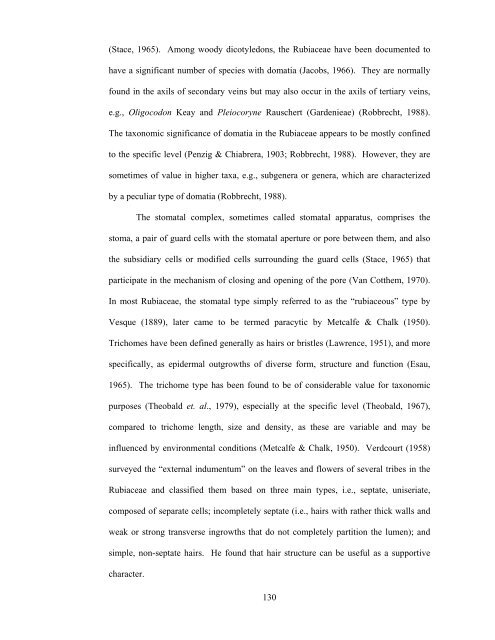Chapter 5.pdf - DSpace@UM
Chapter 5.pdf - DSpace@UM
Chapter 5.pdf - DSpace@UM
You also want an ePaper? Increase the reach of your titles
YUMPU automatically turns print PDFs into web optimized ePapers that Google loves.
(Stace, 1965). Among woody dicotyledons, the Rubiaceae have been documented tohave a significant number of species with domatia (Jacobs, 1966). They are normallyfound in the axils of secondary veins but may also occur in the axils of tertiary veins,e.g., Oligocodon Keay and Pleiocoryne Rauschert (Gardenieae) (Robbrecht, 1988).The taxonomic significance of domatia in the Rubiaceae appears to be mostly confinedto the specific level (Penzig & Chiabrera, 1903; Robbrecht, 1988). However, they aresometimes of value in higher taxa, e.g., subgenera or genera, which are characterizedby a peculiar type of domatia (Robbrecht, 1988).The stomatal complex, sometimes called stomatal apparatus, comprises thestoma, a pair of guard cells with the stomatal aperture or pore between them, and alsothe subsidiary cells or modified cells surrounding the guard cells (Stace, 1965) thatparticipate in the mechanism of closing and opening of the pore (Van Cotthem, 1970).In most Rubiaceae, the stomatal type simply referred to as the “rubiaceous” type byVesque (1889), later came to be termed paracytic by Metcalfe & Chalk (1950).Trichomes have been defined generally as hairs or bristles (Lawrence, 1951), and morespecifically, as epidermal outgrowths of diverse form, structure and function (Esau,1965). The trichome type has been found to be of considerable value for taxonomicpurposes (Theobald et. al., 1979), especially at the specific level (Theobald, 1967),compared to trichome length, size and density, as these are variable and may beinfluenced by environmental conditions (Metcalfe & Chalk, 1950). Verdcourt (1958)surveyed the “external indumentum” on the leaves and flowers of several tribes in theRubiaceae and classified them based on three main types, i.e., septate, uniseriate,composed of separate cells; incompletely septate (i.e., hairs with rather thick walls andweak or strong transverse ingrowths that do not completely partition the lumen); andsimple, non-septate hairs. He found that hair structure can be useful as a supportivecharacter.130
















